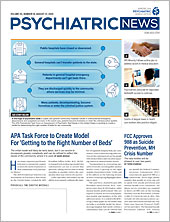I admitted my hospital’s first suspected COVID-19 patient on January 30 while on call at a stand-alone psychiatric facility in New Jersey. At that time, COVID-19 was making headlines as a severe problem in China, and true concern hadn’t yet arisen in the United States. Six months later, New Jersey would be one of the hardest-hit regions in the world by COVID-19, second only to New York, with over 181,000 confirmed cases and over 15,000 dead—more than most countries.
The patient, an international student from China, was suicidal after recently leaving her family and was nauseated and vomiting. She had been in close contact with someone currently hospitalized for symptoms consistent with COVID-19 after returning from China. Hospital staff were concerned, but no precautions were taken beyond encouraging hand hygiene.
To put this decision into context, two weeks prior, the United States had identified its first COVID-19 patient in Washington state, and the Centers for Disease Control and Prevention (CDC) reported that the “immediate risk to the American public is low.” Out of optimism, ignorance, or a combination of both, little was done to mitigate the potential threat this patient posed to the more than 100 patients and staff present in our facility. There was no established protocol—the patient was not tested, she was not isolated, and she was not asked to wear a mask. If she had presented just a few days later, she would have likely been quarantined; national quarantine and testing for symptomatic individuals who had recently been in China went into effect February 2.
Voluntary admissions slowed as fewer patients felt safe to seek treatment for mental health concerns. Inpatient units, which usually had 20 or more patients, now had only five or six. Procedures for handling patients with COVID-19 symptoms trickled in from hospital administrators and the CDC, but we faced many challenges implementing them. Staff, patients, and visitors were screened for cough, fever, and recent travel before entering the building. Symptomatic patients were sent to medical units in other hospitals, and mandatory social distancing procedures were put in place. Eventually group therapy was abolished, and patients ate meals alone in their rooms. Ultimately, visitors were banned entirely.
Implementing even these basic measures was difficult, given the patient population and infrastructure of our facility. Voluntary psychiatric units are built to encourage socialization, with large common rooms and shared bedrooms. Furniture was rearranged and patients were educated, but compliance was intermittent at best.
Patients with active COVID-19 symptoms were being sent to medical floors and posed little risk to our inpatient psychiatric unit. However, infected asymptomatic patients were missed and developed symptoms shortly after admission. These patients posed the greatest risk to our unit as identifying them prior to exposing them to others was impossible.
By April more patients and staff began to fall ill with COVID-19. We felt more vulnerable and poorly prepared. The CDC was encouraging less-ill COVID-19 patients to manage their symptoms at home. Unfortunately, patients admitted to psychiatric facilities cannot be isolated as they would in their own homes—they are exposed to staff members and other patients each day.
Obtaining personal protective equipment (PPE) became one of the biggest challenges. Prior to this epidemic, there was no reason to have large quantities of masks, gowns, and face shields at psychiatric facilities. While our patients are not critically ill with COVID-19, many have mild symptoms; they still require treatment, and we still require protection. Patients need to have physical exams and their vitals taken and blood drawn, and staff need to feel safe. We tried to make do with makeshift isolation gowns, which were nothing more than paper scrubs and inadequate surgical masks. As expected, some staff contracted COVID-19, making an already stressed team shorthanded.
As COVID-19 took over the ICUs and EDs, everyone but the most ill psychiatric patients avoided hospitals. We were treating patients struggling with the acute stress from the economic and social fallout and the paranoia that came with living among an invisible killer. Involuntary units were doing their best to keep up as the EDs filled with involuntary patients. Discharging patients safely became the limiting factor. All outpatient services were closed, long-term-care facilities were full, and civil commitment court was adjourned. The county’s Board of Social Services, the cornerstone for our homeless patients, was closed. It was gridlock—we needed to move patients through the system, but without our outpatient colleagues, that was not possible.
There are many lessons to be learned from this experience. Psychiatry must be self-reflective of our shortcomings and proactive in our response. We must acknowledge and plan for the limitations of our physical infrastructure for isolating patients in response to infectious disease. We must realize that unless there is a seismic, concerted national effort to increase access to PPE in times of crisis, our facilities are unlikely to be a national priority during any shortage of PPE when EDs and ICUs are in need. It will be our responsibility to acquire and maintain adequate PPE for the next pandemic and to train staff in its use. We must keep our institutions financially healthy to weather times of low census. We need creative solutions to safely discharge patients when the services on which we rely are unavailable.
The consequences of ignoring these lessons are fatal, and we must plan to do better if we are to avoid being the next big headline. ■
I would like to thank Jill M. Williams, M.D., and Tracy Martin, M.D., a PGY-2 psychiatry resident at the Rutgers Robert Wood Johnson Medical School, for their help in editing this article. Dr. Williams is a professor of psychiatry and director of the Division of Addiction Psychiatry at the Rutgers Robert Wood Johnson Medical School. She also holds faculty appointments at the Cancer Institute of New Jersey and the Rutgers Center for Alcohol Studies.

